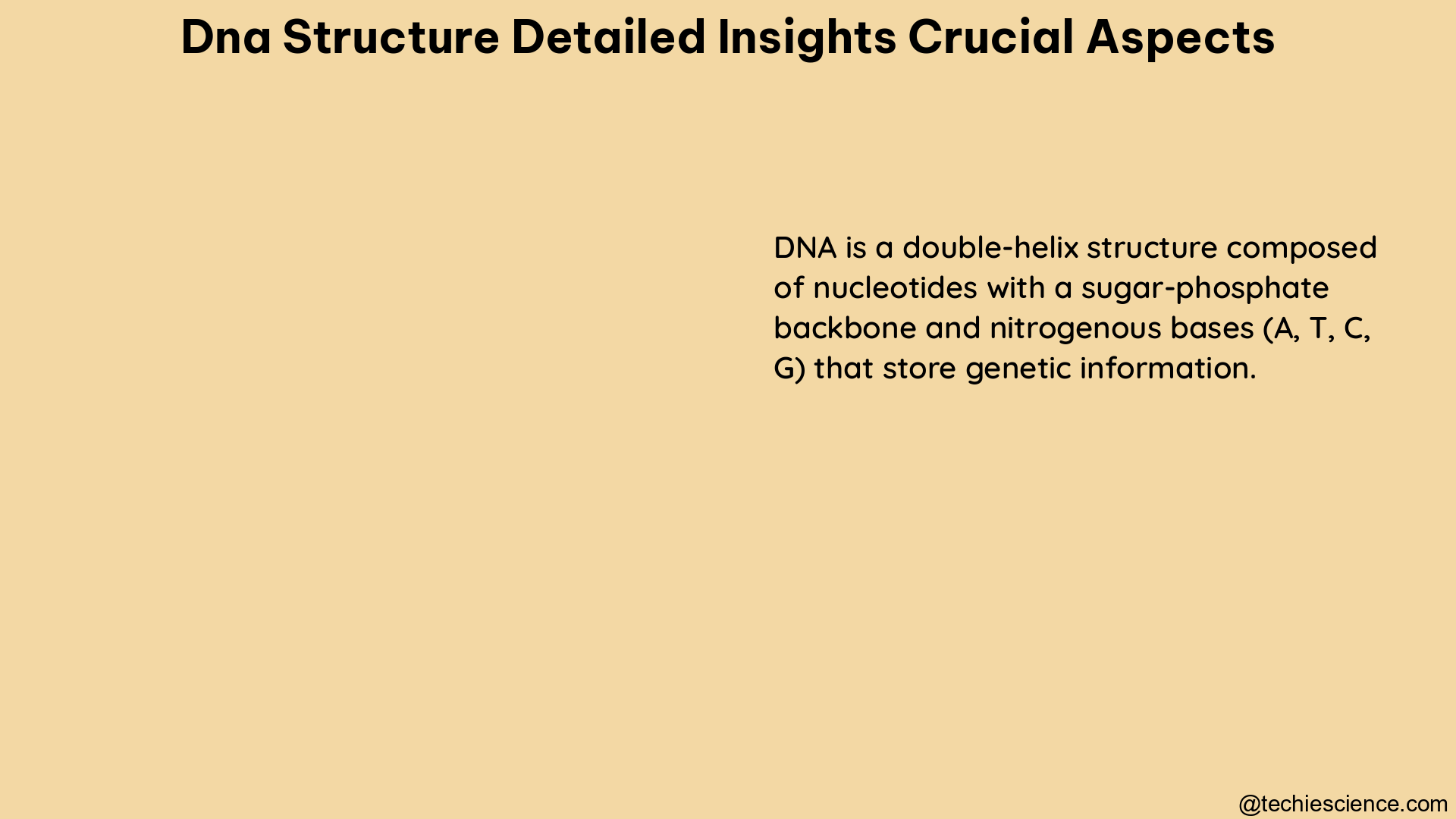DNA, or deoxyribonucleic acid, is the fundamental molecule that carries the genetic information in living organisms. Its intricate structure and unique properties have made it a subject of intense scientific study, with far-reaching implications in fields ranging from genetics to information storage. In this comprehensive blog post, we will delve into the detailed insights and crucial aspects of DNA structure, providing a comprehensive guide for biology students and enthusiasts.
The Double Helix: A Masterpiece of Molecular Engineering
The iconic double-helix structure of DNA, first proposed by James Watson and Francis Crick in 1953, is a marvel of molecular engineering. Each DNA molecule consists of two strands that twist around a central axis, forming a spiral staircase-like structure. These strands are composed of sugar (deoxyribose) molecules, phosphate groups, and four types of nitrogenous bases: adenine (A), thymine (T), guanine (G), and cytosine (C).
The unique pairing of these bases, with adenine always bonding with thymine and guanine always bonding with cytosine, is the foundation of the double-helix structure. This base pairing, known as Watson-Crick base pairing, is crucial for the stability and replication of DNA molecules. The distance between the two strands is approximately 2 nanometers (nm), and the distance between each base pair is around 0.34 nanometers, with a complete turn of the helix occurring every 3.4 nanometers.
Genetic Information Storage: The Unparalleled Density of DNA

One of the most remarkable aspects of DNA structure is its incredible information storage capacity. The four nitrogenous bases (A, T, G, and C) can be arranged in a virtually limitless number of sequences, allowing DNA to store an enormous amount of genetic information in a remarkably small space. In fact, the storage density of DNA is estimated to be around 10^18 bits per cubic millimeter (1 exabit per cubic millimeter), which is several orders of magnitude higher than the maximum density of traditional storage media, such as hard drives or optical discs.
This high storage density is achieved due to the compact nature of the DNA double helix and the efficient packing of the genetic information. Each base pair in the DNA molecule can be considered a single “bit” of information, and the sequence of these base pairs encodes the genetic instructions for the organism. This means that a single gram of DNA can theoretically store up to 455 exabytes (455 billion gigabytes) of data, making it an incredibly dense and efficient storage medium.
Structural Stability and Maintenance: The Resilience of DNA
Another crucial aspect of DNA structure is its remarkable stability and low maintenance requirements. Once synthesized, DNA molecules can be stored for extended periods without significant degradation, unlike traditional storage media, which often require regular maintenance and can degrade over time.
The stability of DNA is largely due to the strong covalent bonds within the sugar-phosphate backbone and the hydrogen bonds between the base pairs. This structural integrity allows DNA to withstand various environmental stresses, such as temperature fluctuations, UV radiation, and chemical exposure, to a much greater extent than other storage materials.
Furthermore, the self-repairing capabilities of DNA, facilitated by enzymes that can detect and correct errors during replication, contribute to its long-term stability and reliability as a storage medium. This inherent resilience makes DNA an attractive option for long-term data storage applications, where the preservation of information is of paramount importance.
Synthesis and Modification: The Versatility of DNA
The ease of DNA synthesis and chemical modification is another crucial aspect of its structure. Advances in biotechnology and DNA synthesis techniques have made it possible to create custom-designed DNA sequences with a high degree of precision. This allows for the encoding of user-defined information into DNA molecules, opening up new possibilities for data storage and retrieval.
The ability to chemically modify DNA, such as by adding functional groups or incorporating non-natural nucleotides, further enhances its versatility. These modifications can be used to improve the stability, accessibility, and information density of DNA-based storage systems, as well as to enable novel applications in areas like molecular computing and biosensing.
Challenges and Opportunities: The Future of DNA-Based Data Storage
While DNA-based data storage holds immense promise, there are still several challenges that need to be addressed. One of the primary challenges is the relatively slow speed of data writing and reading compared to traditional electronic storage media. The current data transfer rates for DNA-based storage systems are in the range of kilobytes per second, which is significantly slower than the gigabytes per second achievable with modern hard drives or solid-state drives.
Researchers are actively exploring various strategies to overcome these speed limitations, such as the development of DNA nanostructures, the integration of DNA with other nanomaterials, and the optimization of enzymatic processes involved in DNA synthesis and sequencing. Additionally, efforts are being made to reduce the cost of DNA-based data storage, which is currently higher than traditional storage solutions.
Despite these challenges, the potential of DNA-based data storage remains immense. As the technology continues to evolve, we can expect to see significant advancements in storage density, access speed, and cost-effectiveness, making DNA an increasingly attractive option for long-term, high-density data storage applications.
Conclusion
The intricate structure of DNA, with its double-helix architecture, precise base pairing, and remarkable storage density, has captivated scientists and researchers for decades. This blog post has provided a comprehensive overview of the detailed insights and crucial aspects of DNA structure, highlighting its unique properties and the exciting possibilities it holds for the future of information storage and beyond.
As we continue to unravel the mysteries of DNA, the potential applications of this remarkable molecule will only continue to grow, transforming the way we store, process, and interact with information. By understanding the intricacies of DNA structure, we can unlock new frontiers in fields ranging from genetics and biotechnology to computer science and materials science, paving the way for a future where the boundaries between biology and technology become increasingly blurred.
References:
- Tomek, K. J., Volkel, K., Simpson, A., Hass, A. G., Indermaur, E. W., Tuck, J. M., & Keung, A. J. (2019). Driving the Scalability of DNA-Based Information Storage Systems. ACS Synthetic Biology, 8(6), 1241–1248. doi:10.1021/acssynbio.9b00100
- Watson, J. D., & Crick, F. H. (1953). A structure for deoxyribose nucleic acid. Nature, 171(4356), 737-738. doi:10.1038/171737a0
- Bošković, F., Ohmann, A., Keyser, U. F., & Chen, K. (2021). DNA Structural Barcode Copying and Random Access. Small Structures, 2(3), 242–248. doi: 10.1038/nbt.4079
- Emerging Approaches to DNA Data Storage: Challenges and Opportunities. (2022). ACS Nano, 16(10), 13628-13630. doi: 10.1021/acsnano.2c06748

I am Abdullah Arsalan , Completed my PhD in Biotechnology. I have 7 years of research experience. I have published 6 papers so far in the journals of international repute with an average impact factor of 4.5 and few more are in consideration. I have presented research papers in various national and international conferences. My subject area of interest is biotechnology and biochemistry with special emphasis on Protein chemistry, enzymology, immunology, biophysical techniques and molecular biology.